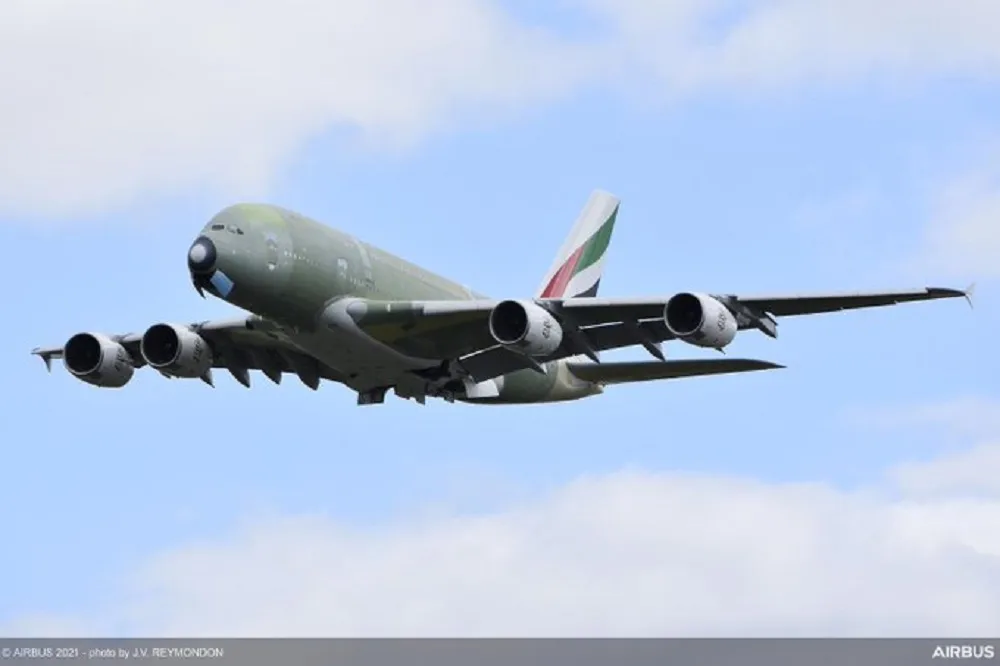
Last A380 takes off on maiden flight.
Mar 18, 2021

In a momentous event for aviation history, the last Airbus A380 took off on its maiden flight, marking the end of an era for the iconic double-decker aircraft. With its impressive wingspan and capacity to carry hundreds of passengers, the A380 has redefined long-haul travel since its introduction. The final flight was celebrated by aviation enthusiasts and industry experts alike, who gathered to witness the culmination of years of innovation and engineering excellence. As the aircraft soared into the sky, it served as a reminder of the impact the A380 has had on global connectivity and the future of air travel.
The Airbus A380, a marvel of modern engineering and the largest passenger aircraft in the world, has officially taken to the skies for its maiden flight one last time. This iconic aircraft has been a symbol of luxury air travel since its introduction, and as we bid farewell to the A380 program, it's essential to reflect on its impact on the aviation industry and the future of air travel.
The Final Chapter of the Airbus A380
The final Airbus A380 took off on its maiden flight, marking the end of an era for this extraordinary aircraft. The A380 was first introduced in the early 2000s and made its commercial debut in 2007. Over the years, it has become a favorite among airlines and passengers alike, renowned for its spaciousness and comfort.
This last flight signifies not only the culmination of a remarkable journey for Airbus but also a shift in the aviation industry towards more fuel-efficient aircraft. As airlines adapt to changing market demands, the focus has shifted towards smaller, more efficient planes that can operate on a wider range of routes.
Specifications and Features of the A380
The Airbus A380 is a double-deck, wide-body, four-engine aircraft that can carry up to 850 passengers in an all-economy configuration. Its spacious interior features large windows, ample storage, and advanced technology, ensuring a comfortable flying experience. Below is a table highlighting some key specifications of the A380:
| Specification | Details |
|---|---|
| Length | 72.7 meters |
| Wingspan | 79.7 meters |
| Maximum Takeoff Weight | 1.2 million pounds |
| Range | 8,000 nautical miles |
| Passenger Capacity | Up to 850 passengers |
The A380's Influence on Air Travel
The Airbus A380 revolutionized long-haul travel, allowing airlines to transport more passengers on popular routes and reduce congestion at airports. Its introduction led to increased competition among airlines, resulting in lower fares and improved services for travelers.
Despite its success, the A380 faced challenges in recent years, including rising fuel costs and a shift in consumer preference towards smaller aircraft. Airlines began to prioritize efficiency and flexibility, leading to a decline in demand for the A380.
Emotional Farewell from Airlines and Passengers
Airline Executives: "The A380 has been a game-changer for our airline, allowing us to offer unparalleled comfort and capacity on key routes," said an airline executive during the farewell ceremony. "We will miss this iconic aircraft but look forward to embracing the future of aviation."
Passenger Experience: "Flying on the A380 was always a dream for me. The spaciousness and comfort made long-haul flights enjoyable," shared a frequent traveler. "I’m sad to see it go, but I will always cherish my memories of flying on this extraordinary plane."
The Future of Aviation
As we say goodbye to the Airbus A380, the aviation industry is poised for a new era. Airlines are increasingly investing in more fuel-efficient aircraft that can adapt to changing travel patterns. The focus is shifting towards sustainability, with manufacturers exploring alternative fuels and electric propulsion systems.
While the A380 may be retiring, its legacy will live on in the evolution of air travel. Innovations in technology and design will continue to shape the future of aviation, ensuring that passengers experience the highest levels of comfort and efficiency.
Conclusion
The final maiden flight of the last Airbus A380 marks a significant milestone in aviation history. This remarkable aircraft has left an indelible mark on the industry and the hearts of travelers around the world. As we reflect on its contributions and embrace the future of air travel, the A380 will always be remembered as a symbol of luxury and innovation in aviation.
As airlines transition to newer models, the spirit of the A380 will influence the design and functionality of future aircraft. The legacy of this giant will continue to inspire generations of aviation enthusiasts and travelers for years to come.
In conclusion, the Airbus A380 will forever hold a special place in the world of aviation, serving as a reminder that progress is a journey, and every ending paves the way for new beginnings in air travel.
Related Articles

Explore Thailand: The Best Islands to Visit for Paradise, Adventure, and Relaxation

The Ultimate Guide to the Best Islands in Thailand for Your Next Getaway

Do babies need passports? How to get a passport for a newborn

How to get a U.S. passport fast: here’s how to expedite the process

What is Mobile Passport Control: 5 reasons why you should use it

SENTRI vs. Global Entry: A detailed guide

Do you need a passport to go to the Bahamas? Let’s find out

Do you need a passport to go to Mexico? A detailed guide

Do you need a passport to go to Canada? We got the answer

Do You Need a Passport for a Cruise: An Essential Travel Guide

Booster Seat Requirements: All the Rules to Follow in Your Rental Car

What Are the World’s Most Powerful Passports, and How Does Yours Rank?

How to Take a Passport Photo at Home: A Helpful Guide

You've got to have heart! Southwest's new livery

Your opinion: Should water be free on low cost carriers?

Young women bolder than guys as solo travellers
